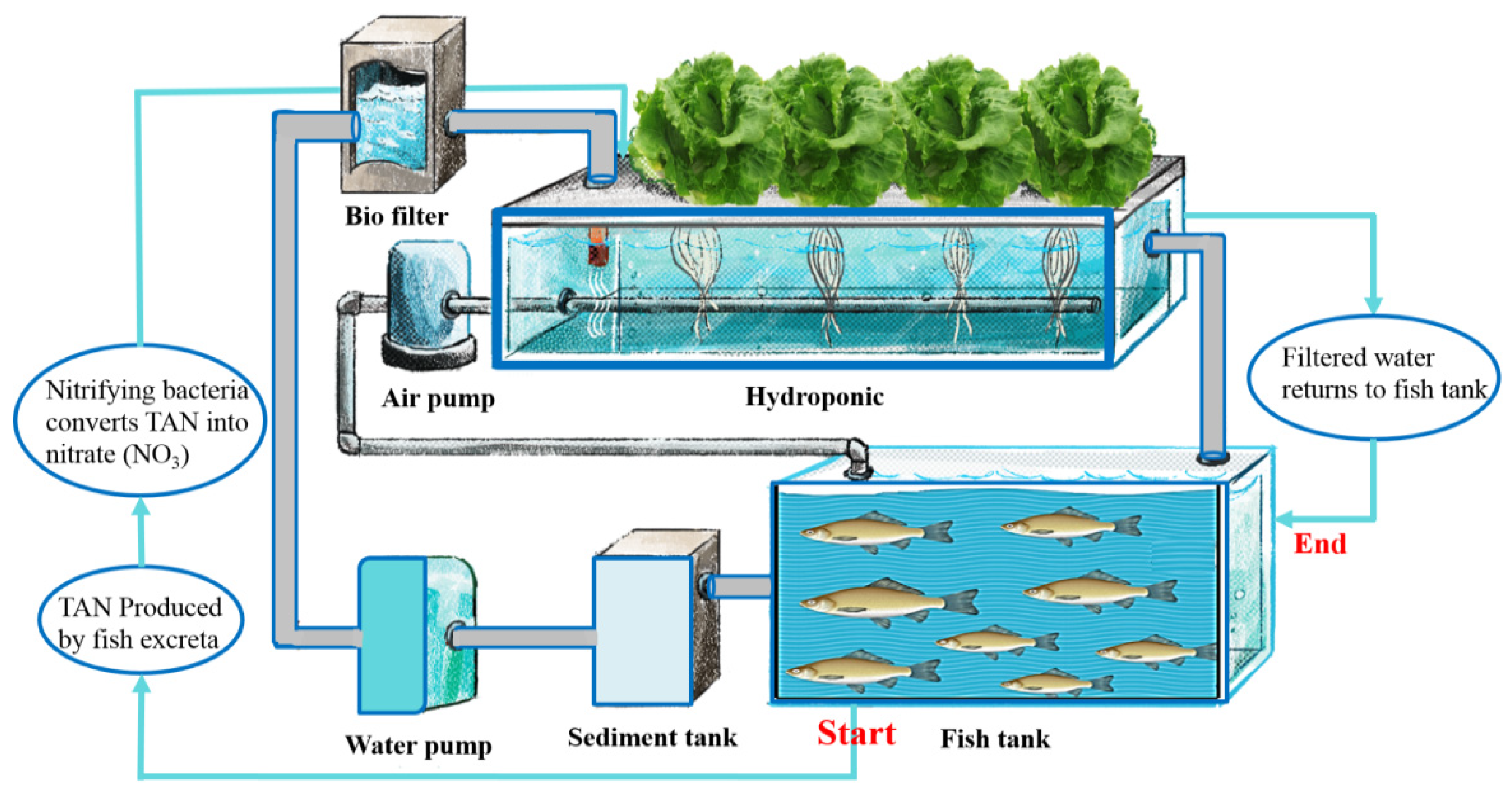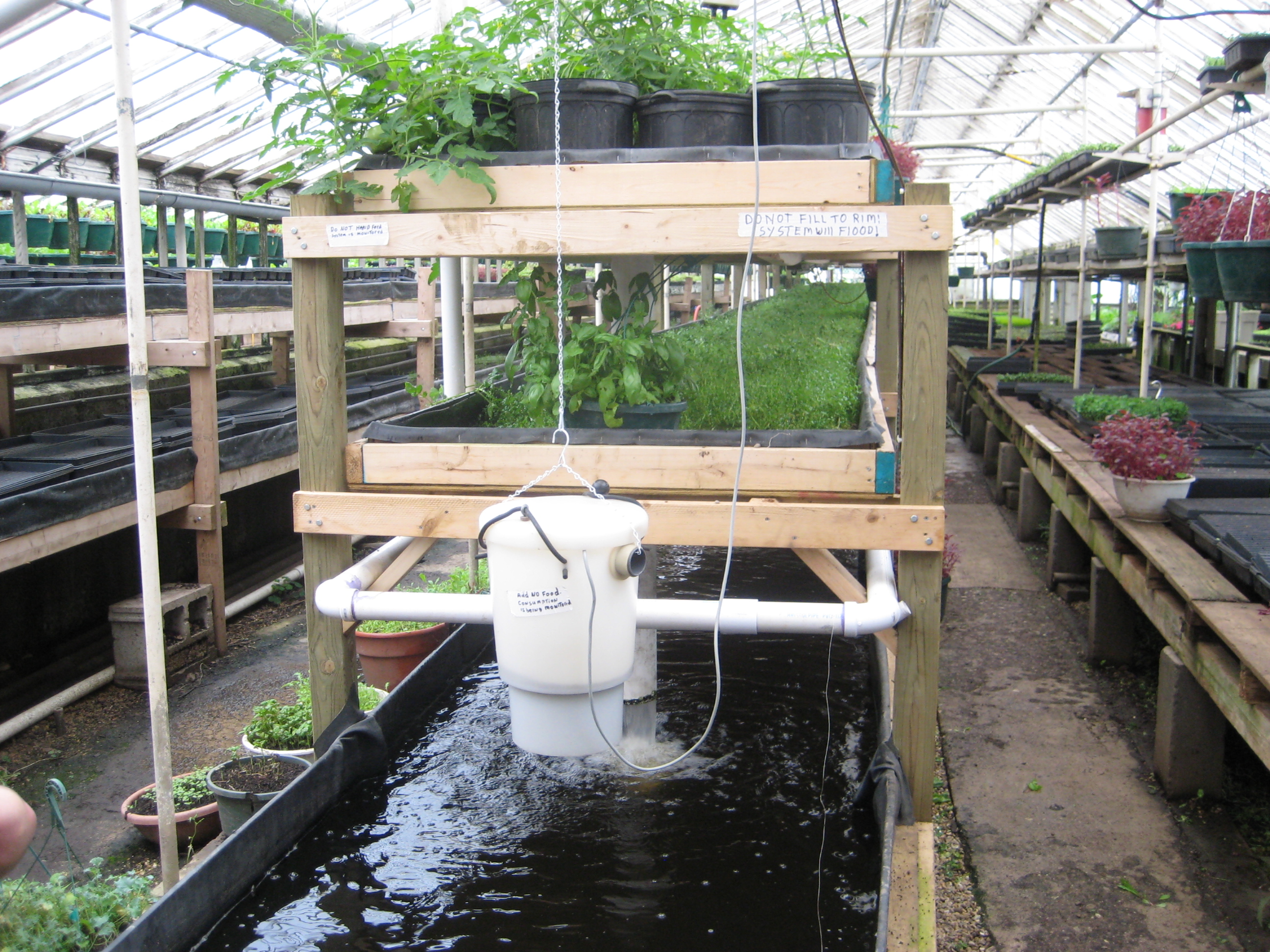Dive into the world of automated aquaponics systems, an innovative approach to sustainable food production that combines aquaculture and hydroponics. Discover the benefits, components, design considerations, and advanced technologies that empower these systems to enhance efficiency and productivity.
From concept to implementation, this comprehensive guide provides a roadmap for understanding and harnessing the potential of automated aquaponics systems.
Automated Aquaponics System Overview

An automated aquaponics system combines aquaculture (fish farming) with hydroponics (plant cultivation in water). This system leverages the symbiotic relationship between fish and plants to create a self-sustaining ecosystem.
Automated aquaponics systems use sensors, controllers, and software to monitor and adjust environmental parameters, ensuring optimal conditions for both fish and plants. These systems offer advantages such as increased efficiency, reduced labor costs, and improved crop yields.
Components of an Automated Aquaponics System
- Fish Tank:Houses the fish, providing a controlled environment for their growth.
- Grow Beds:Contain the plants, providing a nutrient-rich environment for their growth.
- Water Pump:Circulates water between the fish tank and grow beds.
- Biofilter:Removes waste from the water, converting it into nutrients for the plants.
- Sensors:Monitor environmental parameters such as pH, temperature, and dissolved oxygen.
- Controllers:Receive data from sensors and adjust system parameters accordingly.
- Software:Manages the system, providing real-time monitoring and data analysis.
Benefits of Automated Aquaponics Systems
Automated aquaponics systems offer a range of advantages that can significantly enhance efficiency, productivity, and overall management of aquaponics operations.
By leveraging automation, aquaponics systems can streamline various tasks, reduce labor requirements, and optimize environmental conditions, leading to improved crop yields and fish health.
Enhanced Efficiency
- Automated feeding:Automatic feeders can dispense precise amounts of fish feed at scheduled intervals, ensuring optimal nutrition for fish and reducing the risk of overfeeding or underfeeding.
- Water quality monitoring and control:Automated sensors can continuously monitor water parameters such as pH, temperature, and dissolved oxygen, and trigger adjustments to maintain optimal conditions for both fish and plants.
- Automated water filtration and circulation:Automated pumps and filters can continuously remove solids and contaminants from the water, maintaining water quality and preventing disease outbreaks.
Increased Productivity
- Optimized plant growth:Automation allows for precise control of environmental conditions such as lighting, temperature, and nutrient levels, resulting in increased plant growth rates and yields.
- Improved fish health:Automated water quality monitoring and control systems help maintain optimal conditions for fish, reducing stress and disease, and improving overall health and survival rates.
- Reduced labor costs:Automation can eliminate or reduce the need for manual labor in tasks such as feeding, water quality monitoring, and filtration, freeing up time for other essential activities.
Improved Management, Automated aquaponics system
- Remote monitoring:Automated systems can be equipped with remote monitoring capabilities, allowing operators to monitor and control the system from anywhere with an internet connection.
- Data collection and analysis:Automated systems can collect and store data on water parameters, fish feeding, and plant growth, providing valuable insights for optimizing operations and making informed decisions.
- Reduced risk of human error:Automation eliminates the risk of human error in critical tasks such as feeding, water quality monitoring, and filtration, ensuring consistent and reliable operation.
Design and Implementation of Automated Aquaponics Systems
Automated aquaponics systems are designed to optimize plant growth and fish production by automating various tasks, such as water quality monitoring, nutrient dosing, and feeding. To design and implement an effective automated aquaponics system, several key considerations must be taken into account.
The first step in designing an automated aquaponics system is to determine the specific goals and objectives of the system. This includes identifying the types of plants and fish to be grown, the desired production scale, and the available resources.
System Components
The core components of an automated aquaponics system include:
- Fish tank: This is where the fish are raised. The size of the fish tank will depend on the number of fish to be stocked.
- Grow beds: These are where the plants are grown. The grow beds can be made from a variety of materials, such as plastic, fiberglass, or concrete.
- Water filtration system: This system removes waste products from the water and returns clean water to the fish tank.
- Nutrient dosing system: This system adds nutrients to the water to support plant growth.
- Feeding system: This system provides food to the fish.
- Monitoring and control system: This system monitors the water quality and controls the operation of the other system components.
Implementation Considerations
When implementing an automated aquaponics system, it is important to consider the following factors:
- Water quality: The water quality in an aquaponics system must be carefully monitored and maintained within specific parameters to ensure the health of the fish and plants.
- Nutrient management: The nutrient levels in the water must be carefully managed to ensure that the plants have the nutrients they need to grow properly.
- Fish feeding: The fish must be fed a nutritious diet to ensure their health and growth.
- System maintenance: Automated aquaponics systems require regular maintenance to ensure that they are operating properly.
Components of Automated Aquaponics Systems
Automated aquaponics systems rely on a combination of components to function efficiently. These components work together to create a closed-loop ecosystem where fish, plants, and beneficial bacteria coexist in harmony.
The essential components of an automated aquaponics system include:
| Component | Function |
|---|---|
| Fish tank | Holds the fish and provides a controlled environment for their growth. |
| Grow beds | Holds the plants and provides a place for them to absorb nutrients from the water. |
| Water pump | Circulates water between the fish tank and grow beds, carrying nutrients to the plants. |
| Biofilter | Removes harmful bacteria and other impurities from the water, ensuring a healthy environment for the fish. |
| Nutrient dosing system | Monitors and adjusts the nutrient levels in the water, ensuring optimal plant growth. |
| pH and temperature sensors | Monitor the pH and temperature of the water, ensuring optimal conditions for fish and plant health. |
| Control system | Monitors and controls the system’s components, ensuring optimal operation and efficiency. |
These components work together to create a self-sustaining ecosystem where fish waste provides nutrients for plants, and plants filter and clean the water for fish. The control system ensures that all components operate efficiently, maintaining optimal conditions for both fish and plants.
Monitoring and Control Systems for Automated Aquaponics
Monitoring and control systems are crucial in automated aquaponics as they allow for precise monitoring and adjustment of various parameters to maintain optimal conditions for both plants and fish. These systems ensure that the aquaponics system operates efficiently and effectively, maximizing productivity and minimizing losses.
Different types of monitoring and control systems are available for automated aquaponics, each with its advantages and disadvantages. These systems typically consist of sensors, controllers, and actuators that work together to monitor and adjust parameters such as pH, temperature, dissolved oxygen, nutrient levels, and water flow.
Sensor Technologies
Sensors play a vital role in monitoring and control systems by providing real-time data on various parameters. Common sensor technologies used in automated aquaponics include:
- pH sensors:Measure the acidity or alkalinity of the water.
- Temperature sensors:Monitor water and air temperature.
- Dissolved oxygen sensors:Measure the amount of dissolved oxygen in the water.
- Nutrient sensors:Monitor the levels of essential nutrients for plant growth.
- Water flow sensors:Measure the flow rate of water through the system.
Advanced Technologies in Automated Aquaponics

Advanced technologies play a crucial role in enhancing the performance and efficiency of automated aquaponics systems. These technologies include:
Artificial Intelligence (AI)
AI algorithms can analyze real-time data from sensors to optimize system parameters such as water temperature, pH, and nutrient levels. This helps maintain optimal conditions for both fish and plants, improving growth and yields.
An automated aquaponics system is a cutting-edge approach to farming that combines aquaculture and hydroponics. It allows for the production of both fish and hydroponics crops in a single, controlled environment. By utilizing nutrient-rich water from fish tanks to fertilize hydroponically grown plants, this system promotes sustainability and efficiency.
Automated aquaponics systems offer numerous benefits, including reduced water consumption, increased crop yields, and improved resource utilization.
Machine Learning (ML)
ML algorithms can learn from historical data to predict system behavior and make informed decisions. For example, ML models can forecast fish growth rates and adjust feeding schedules accordingly, reducing waste and optimizing resource allocation.
Internet of Things (IoT)
IoT devices connect sensors, actuators, and controllers to a central platform, enabling remote monitoring and control of the system. This allows farmers to access real-time data and make adjustments from anywhere, improving responsiveness and reducing the need for manual interventions.
Robotics
Robotic systems can automate tasks such as fish feeding, plant harvesting, and system maintenance. This reduces labor costs, improves precision, and enhances overall system efficiency.
Computer Vision
Computer vision algorithms can analyze images and videos to detect fish health issues, monitor plant growth, and identify potential problems. This enables early detection and timely intervention, minimizing losses and improving system resilience.
Troubleshooting and Maintenance of Automated Aquaponics Systems

Ensuring optimal performance and longevity of automated aquaponics systems requires effective troubleshooting and maintenance practices. Regular monitoring and prompt attention to potential issues are crucial for maintaining system efficiency and fish and plant health.
Common Troubleshooting Issues
- Water quality issues:Monitor water parameters regularly for pH, ammonia, nitrite, and nitrate levels. Adjust as needed to maintain optimal ranges for fish and plant health.
- Pump failures:Inspect pumps regularly for blockages, leaks, or damage. Clean or replace pumps as necessary to ensure proper water circulation and filtration.
- Clogged filters:Regularly clean or replace filters to remove debris and maintain water quality. Backwash or rinse filters as per manufacturer’s instructions.
- Plant health problems:Observe plants for signs of nutrient deficiencies, pests, or diseases. Adjust nutrient levels or implement pest and disease management strategies as needed.
- Power outages:Install backup power systems or generators to prevent system failure during power outages. Monitor water quality closely after power is restored.
Maintenance Procedures
Regular maintenance is essential for optimal system performance and longevity. Key maintenance procedures include:
- Regular water testing:Monitor water parameters and adjust as necessary to maintain optimal ranges for fish and plant health.
- Filter cleaning:Clean or replace filters regularly to remove debris and maintain water quality.
- Pump inspection:Inspect pumps for blockages, leaks, or damage. Clean or replace pumps as necessary.
- Plant monitoring:Observe plants for signs of nutrient deficiencies, pests, or diseases. Adjust nutrient levels or implement pest and disease management strategies as needed.
- System cleaning:Clean the system regularly to remove debris, algae, or other contaminants. Use appropriate cleaning agents and disinfectants as needed.
Outcome Summary
In the realm of automated aquaponics systems, we’ve explored the benefits, components, design considerations, and cutting-edge technologies that shape these systems. By embracing this innovative approach, you can unlock a sustainable and efficient way to produce food, fostering a harmonious balance between aquaculture and hydroponics.
Frequently Asked Questions: Automated Aquaponics System
What are the key components of an automated aquaponics system?
Essential components include grow beds, fish tanks, water pumps, filters, and monitoring systems.
How does automation enhance efficiency in aquaponics?
Automation automates tasks such as feeding, water quality monitoring, and temperature control, reducing labor and increasing precision.
What are the benefits of using an automated aquaponics system?
Benefits include increased productivity, reduced water consumption, improved water quality, and a controlled environment for both plants and fish.
